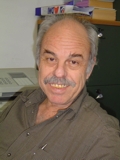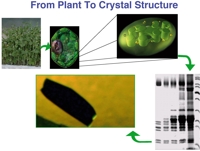
Department of Biochemistry and Molecular Biology, The George S. Wise Faculty of Life Sciences, Tel Aviv University, Tel Aviv 69978, Israel
e-mail: nelson@post.tau.ac.il
URL: http://www.tau.ac.il/lifesci/departments/biochem/members/nelson/nelson.html

 |
Yuval Mazor, Hila Toporik, Ilanit Greenberg, and Nathan Nelson
Department of Biochemistry and Molecular Biology, The George S. Wise Faculty of Life Sciences, Tel Aviv University, Tel Aviv 69978, Israel e-mail: nelson@post.tau.ac.il URL: http://www.tau.ac.il/lifesci/departments/biochem/members/nelson/nelson.html |
 |
Oxygenic photosynthesis is driven by two Photosystems I and II. Despite its enormous complexity, the plant PSI is arguably the most efficient nano-photochemical machine in Nature. It emerged as a homodimeric structure containing several chlorophyll molecules over 3.5 billion years ago, and has perfected its photoelectric properties ever since. The recently determined structure of plant PSI, which is at the top of the evolutionary tree of this kind of complexes, provided the first relatively high-resolution structural model of the supercomplex containing a reaction center and a peripheral antenna complexes. Our recent studies of the structure of photosystem I encoding operon in a marine phage painted clearer picture of PSI evolution. Using genetic engineering we demonstrated that the fused PsaJF subunit from the phage, substituted for the two separate subunits in Synechocystis, enabled the mutated PSI to accept electrons from additional electron donors, such as respiratory cytochromes. In this way, novel photorespiration was created in which PSI could substitute for cytochrome oxidase.
The study of the interaction between biological proteins and solid-state substrates gains wider interest in recent years. We utilized light and dried plant PSI crystals for the fabrication of such electronic device. The relatively long distance of about 50 ┼ between the electron donor FB in one layer to the electron acceptor, oxidized P700 in the next layer, enables the layers to act as electric generators in series. Since theoretically every layer can generate a potential of 1 Volt and the thickness of every layer is about 10 nm, a 5 µm thick crystal has 500 layers thus could potentially generate 500 V upon illumination. Obviously this is not possible because no material 5 µm thick will withstand such large voltage. We were able to demonstrate that crystals placed on a conducting surface generated in the light an electric potential of over 13 V (as measured by KPFM) that slowly decayed in the dark. Currently, 13 V is the upper limit of our measuring capacity. In fact, the photopotential generated by the crystals is much higher than 13 V and we estimate that in some experiments our PSI crystals can generate potentials as high as 50 V. The challenge for the future is to fabricate atomic wires at the gap between FB and the neighbor P700.